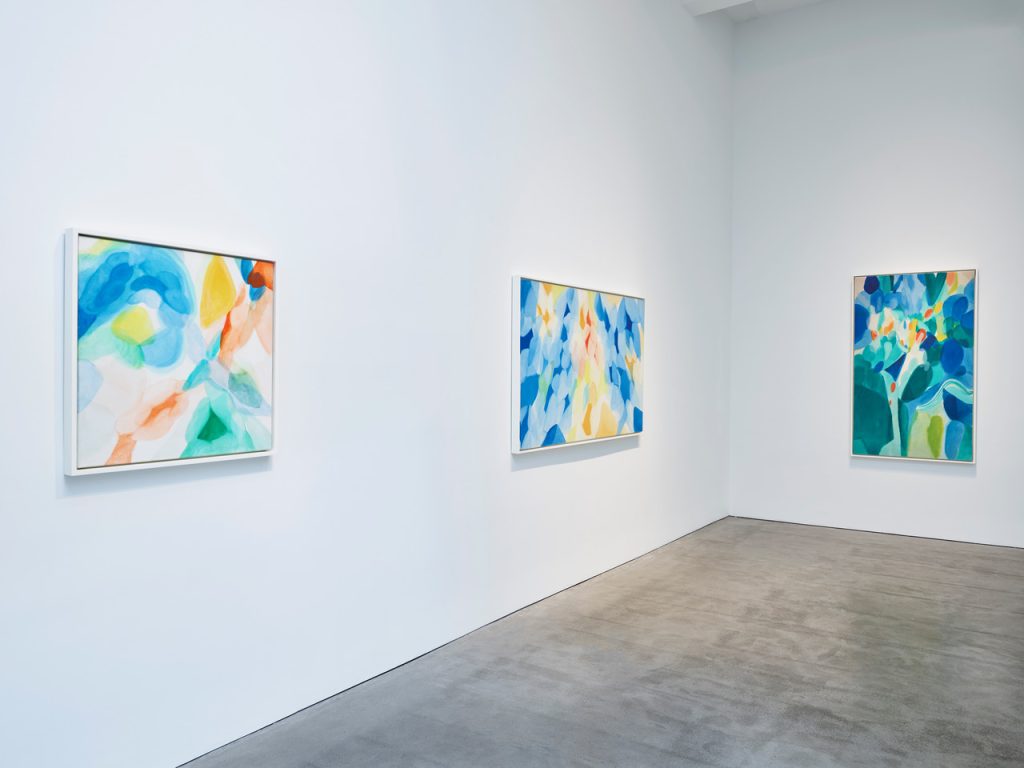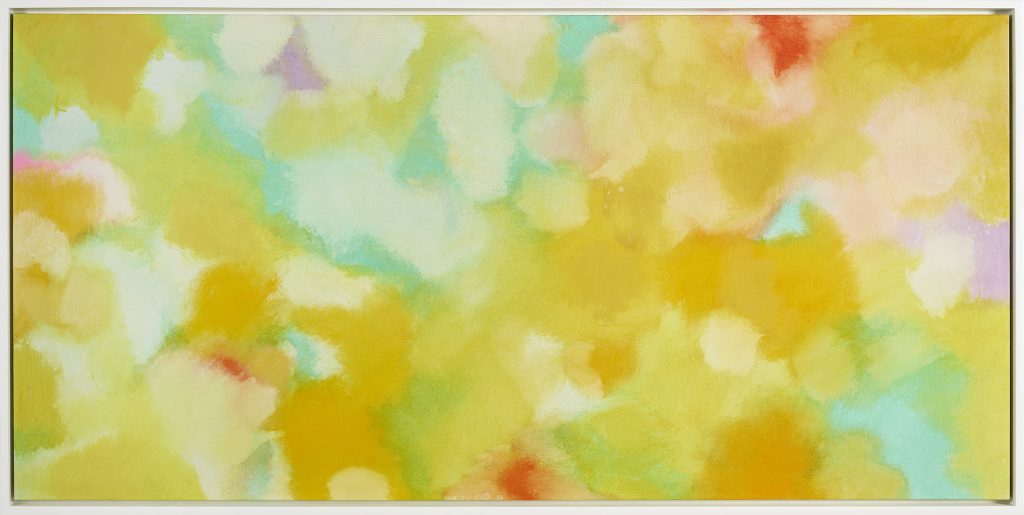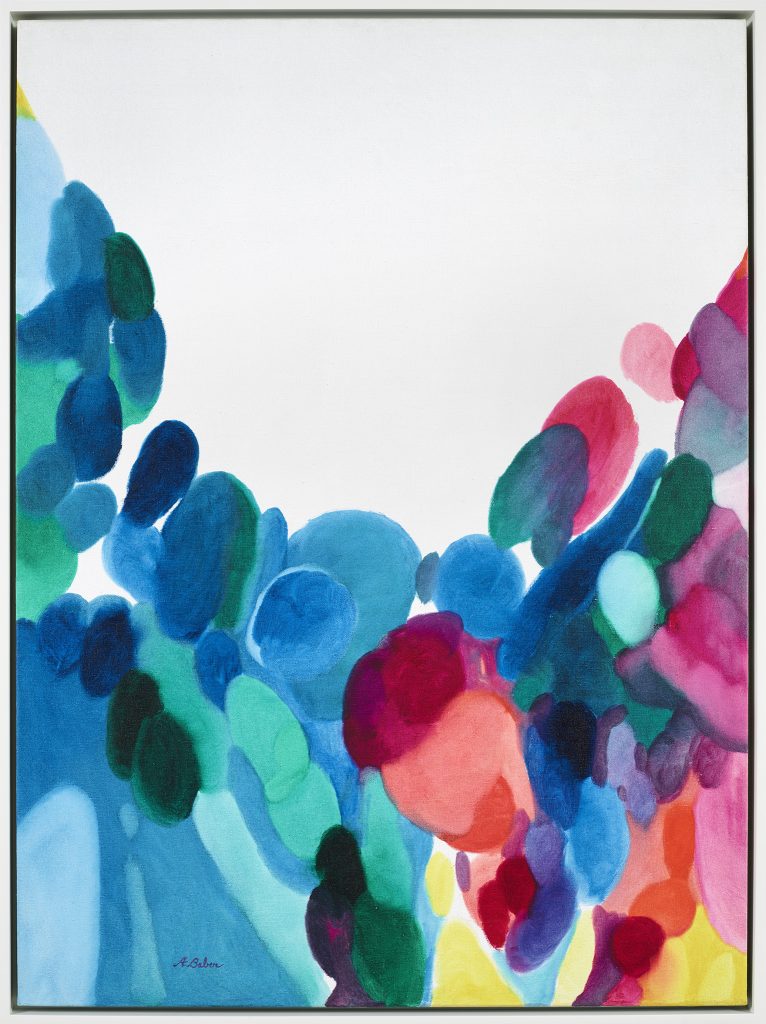Before my recent visit to “Alice Baber: Reverse Infinity” at the art gallery Berry Campbell, I saw work by the late artist on display at the auction house Sotheby’s. The always intriguing Berry Campbell, who show art in New York City’s Chelsea neighborhood, call this new show the first exhibition at this scale showcasing Baber’s work in several decades, making “Reverse Infinity” an event and lending the exhibition an air of gravitas.
Baber’s Methods of Making
Baber’s paintings spotlighted in these contexts share similarities in overall composition, with the artist finding a remarkable richness within that world. She worked with shapes that repeated across her surfaces, using the sometimes rounded and other times oblong but often organic forms as individual splashes of color. Many of the shapes were entirely comprised of a single color, amplifying the impact.
Those are generally the two elements that lead the most in Baber’s startlingly evocative paintings: color and form. The elevating artworks freely glimmer, capturing something timeless and uplifting from the everyday feelings and scenes that they invoke. Sans much of anything but the color and its shape, a lot of this is quite energizing, veering between evident method and bursts of energy as Baber sticks to similar patterns of picture construction but freely shifts, intermingles, and otherwise alters the color palettes and shapes.
The overall collections of forms across each individual work generally move with ease, as though an analogue to light gusts of wind on a warm day or, in whatever context, showing something alive or imbued with life.
Baber’s “The Blue Bow of The Jaguar” (1981), an oil-on-canvas work, features one such flow, with small diamond shapes of red, yellow, and blue stretching across the surface in a curved, lightly twisting pattern that is evocative, perhaps, of a piece of string dropped to the ground.
The Paintings’ Enrapturing Emotional Worlds
Baber’s “The Green Reed” (1966), in which the artist’s shapes fill the entire canvas surface, suggested a sunny outdoors scene — or concurrent moods — with its color palette that’s led, visually, by a lot of green and blue.
The visual rhythm of the painting’s shapes could suggest inward tension that’s subsequently resolved, with bigger forms flowing from a portion in the upper middle where things get a lot smaller and that tension might come in, since there’s more of an opportunity for the build-up to intensify if component forms are smaller.
The greens and blues define the larger forms towards the bottom, bounding things with a feeling of cool, grounded stability. Baber uses red, yellow, and orange for some of those smaller forms, with a lot of what’s across the entire canvas meshing, essentially, into nearby forms’ space. There is some overlap, but it’s kept under control, ending up at a level that’s just enough to add some heat to these spatial interactions.
There’s still a certain stability and, if you imagined things in an emotional sense, an understanding, as though pieces of slowly disassembling memories of a fondly recalled but strained past are locking into tentative place, even though the precision of the three-dimensional world is absent. The progressions, though impactful, are gradual and smooth, accepting of juxtaposition.
Baber’s applications of oil paint are relatively thin, another defining feature in these paintings’ visual impact, which feels like a spectrum of calm confidence. That Baber’s shapes are often on the smaller side compared to the surface lends to this, because it ends up a more methodical buildup to the painting’s full impact.
(“The Green Reed” is all of the way on the right in the below image.)

Celestial Reckonings in Baber’s Work
Another definite standout piece is “Flotilla” (1962), in which Baber’s latest collection of forms fill the entire surface of the oil-on-linen artwork. There’s a lot of rounding to how these individual forms are shaped, keeping the rhythm less than jarring, but it’s nonetheless absolutely soaring because of how much is packed in here. The variety in the forms’ actual orientation on the linen combined with the ample overlap gives the piece a sweeping, even skyward energy, and the color palette amplifies this sense beautifully.
What definitely captures the most space, impact-wise, is the golden-yellow, but a critical support comes from a soft green that’s just outside of the palette of greens that would most directly mirror where we see that the most — nature — but still delivers a comforting, enveloping touch.
So the rich gold bouncing off that green extends the first color’s shimmer and expanse, and the pattern of forms basically leaps from the surface to meet and carry that crescendo even further. The piece feels less like a work of art confined to a rectangle and more on par with a snapshot of the extensive inner workings of something beautiful and far above our earthly confines.
“Flotilla,” though, keeps a personal touch, considering Baber’s methodical application of paint and the relative consistency that emerges in something even as sweeping as this. The particularities of that painting method feel foundational, as it makes Baber’s art on canvas or linen feel like it breathes. In contrast with, say, a lot of what might be done with acrylics, oil paint and the manner specifically in which Baber uses it have inner space, with texture from the picture’s backing still visible and the oils themselves adding their own slowly progressing tactility.
Baber’s style is distinctive, suggesting — the longer you look at these forms — the systematization that defines our everyday life experiences but insisting on sticking to visions that unify.
Alice Baber: Reverse Infinity is on view at Berry Campbell in New York through May 18.
Featured image: Installation View, Alice Baber: Reverse Infinity, Berry Campbell, New York, 2024
Courtesy Berry Campbell, New York.


You may also like
-
Diana Kurz at Lincoln Glenn in New York: A Review of a Shining Art Exhibition
-
Dustin Hodges at 15 Orient in New York City: An Ensnaring Exhibition at an Exciting Gallery
-
Maren Hassinger at Susan Inglett Gallery in New York: Reviewing an Uplifting Art Exhibition
-
Enzo Shalom at Bortolami in New York City: Reviewing an Entrancing Exhibition of Paintings
-
“Ben Werther: Townworld” at Amanita in New York City: Reviewing a Richly Memorable Art Exhibition
